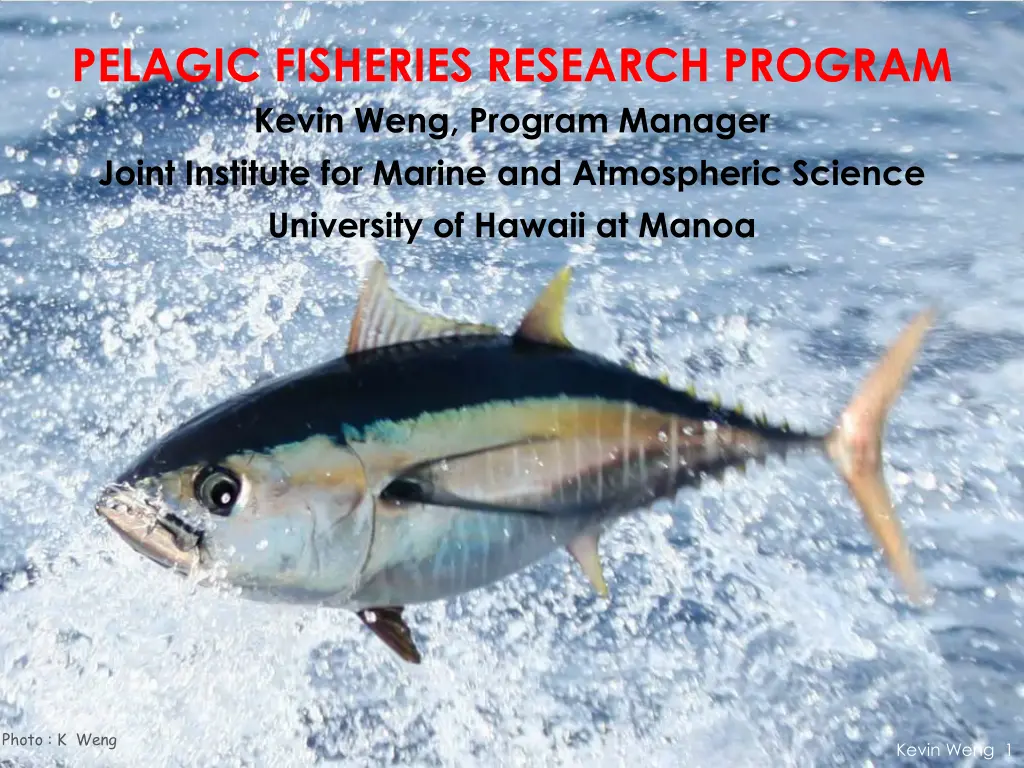
Understanding the Pelagic Fisheries Research Program Led by Kevin Weng
Explore the history, operations, and impactful research of the Pelagic Fisheries Research Program managed by Kevin Weng at the University of Hawaii. Learn about their efforts in ecosystem modeling, modifying longlines to reduce turtle bycatch, and more.
Download Presentation

Please find below an Image/Link to download the presentation.
The content on the website is provided AS IS for your information and personal use only. It may not be sold, licensed, or shared on other websites without obtaining consent from the author. If you encounter any issues during the download, it is possible that the publisher has removed the file from their server.
You are allowed to download the files provided on this website for personal or commercial use, subject to the condition that they are used lawfully. All files are the property of their respective owners.
The content on the website is provided AS IS for your information and personal use only. It may not be sold, licensed, or shared on other websites without obtaining consent from the author.
E N D
Presentation Transcript
PELAGIC FISHERIES RESEARCH PROGRAM Kevin Weng, Program Manager Joint Institute for Marine and Atmospheric Science University of Hawaii at Manoa Photo : K Weng Kevin Weng 1
History of the PFRP Established 1992: John Sibert, Program Manager Univ of Hawaii SOEST JIMAR (Coop. Inst.) Magnuson Stevens Act amended to include "highly migratory fish large increase in role of WesPac Science, social science & economics relevant to fishery management Tunas, billfishes, sharks, protected species Kevin Weng 2
Operations Annual request for proposals with peer review, panel and steering committee Budget: 0.5 2 million USD annually Earmark / Bluebook Participation in WesPac, WCPFC meetings Oversight by University, NOAA, WesPac Kevin Weng 3
End-to-end Ecosystem Model: SEAPODYM Lehodey, P., Senina, I., and Murtugudde, R., 2008, A spatial ecosystem and populations dynamics model (SEAPODYM) - Modeling populations: Progress in Oceanography, v. 78, p. 304- 318. of tuna and tuna-like Lehodey, P., Senina, I., Sibert, J., Bopp, L., Calmettes, B., Hampton, J., and Murtugudde, R., 2010, Preliminary forecasts of Pacific bigeye tuna population trends under the A2 IPCC scenario: Progress in Oceanography, v. 86, p. 302-315. The PFRP has funded development of computer models that describe the entire ecosystem, from climate to algae to the animals that eat them and the big animals that humans like to eat. Such models will bridge the gap between single species management and ecosystem-based management. This figure shows an estimate of skipjack tuna distribution from the SEAPODYM model (Source: I. Senina, P. Lehodey). Lehodey, Senina et al Kevin Weng 6
Modifying longlines to avoid turtles and birds Beverly, Steve, Daniel Curran, Michael Musyl and Brett Molony. 2009. Effects of eliminating shallow hooks from tuna longline sets on target and non-target species in the Hawaii- based pelagic tuna Research 96 (2009) 281-288. fishery. Fisheries Swimmer, Y., R. Arauz, B. Higgins, L. McNaughton, M. McCracken, J. Ballestero, and R. Brill, 2005. Food color and marine turtle feeding behavior: Can blue bait reduce turtle bycatch in commercial fisheries? Marine Ecology Progress Series, v. 295: 273- 278, June 23, 2005 PFRP-funded research showed that when sea turtles are caught on longlines, they are nearly always on hooks that are nearer to the surface of the water. As a result, the catch of turtles can be reduced by deploying the longline so that the hooks are deeper in the water (Photos: Y. Swimmer, K. Weng). Kevin Weng 7
Reducing bycatch, eg turtles, sharks Kevin Weng 8
Fournier, D., Hampton, J., Sibert, J., 1999. MULTIFAN-CL: a length-based, age-structured model for fisheries stock assessment, with application to south Pacific albacore, Thunnus alalunga. Canadian Journal of Fisheries and Aquatic Sciences, 55:2105 - 2116 Kevin Weng 9
Stock assessments used by international RFMOs (WCPFC, SPC) Kevin Weng 10
Easy front end to MULTIFAN-CL Usable by managers During meetings / negotiations Allows new scenarios to be evaluated without lengthy back-and-forth with science provider Hoyle, Hampton et al. SPC Kevin Weng 11
Thank you Kevin Weng 14
